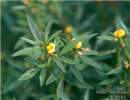Scientific name(s)
Stylosanthes hamata
Strengths
- Can be oversown into native pasture or grown with sown grasses.
- Grows on low fertility soils.
- Highly persistent under grazing.
- Little effect of anthracnose disease.
Limitations
- Intolerant of waterlogging.
- Frost sensitive.
- Restricted to warmer environments.
Plant description
Plant: annual or short-lived, much-branched, prostrate to semi-erect perennial legume, growing to about 75cm tall.
Stems: younger stems are fine and green, with fine white hairs down one side (but no bristles as in Townsville stylo).
Leaves: comprising three narrow, pointed leaflets 1.5 to 2.5cm long.
Flowers: small (4 -5mm wide), mainly yellow, pea-like flowers with red markings.
Pods: comprising two single-seeded segments 4 - 7mm long, the upper segment bearing a short hook.
Seeds: fawn to brown or maroon in colour (often mottled), with about 270,000 seeds-in-pod or 450,000 dehulled seeds/kg. May have high levels of hard seed.
Pasture type and use
It is often sown into native pasture in the seasonally dry and wet tropics, and warmer subtropics, and provides a useful component in mixed introduced grass/legume permanent pasture.
Where it grows
Rainfall
Although mostly sown in areas receiving 700 - 900mm average annual rainfall, it may also be successful at lower (to 500mm) and higher(to 2,000mm) annual rainfalls.
Soils
It grows well on most soils with pH of 5.4 to 8.0, but not on heavy clays.
Temperature
Very susceptible to frosting.
Establishment
Companion species
Grasses: Indian bluegrass (Indian couch), sabi grass
Legumes: American jointvetch, cassia, stylo, shrubby stylo.
Sowing/planting rates as single species
Up to 4kg seed-in-pod/ha (need higher levels of commercially coated seed to give similar number of seeds/unit area.
Sowing/planting rates in mixtures
1 - 2kg seed-in-pod/ha (need higher levels of commercially coated seed to give similar number of seeds/unit area).
Sowing time
Best sown at the end of the dry season.
Inoculation
While the specific inoculum (CB 1650) is most effective for caribbean stylo, Group M inoculum (CB 756) can be used if CB 1650 not available.
Fertiliser
Although it is adapted to soils low in available soil phosphorus, an application of 100 - 200 kg/ha superphosphate at sowing will be beneficial on very infertile soils. Molybdenum (Mo) and sulphur (S) may also be necessary in some situations.
Management
Maintenance fertliser
An application of 100 - 200 kg/ha superphosphate every 2 or 3 years after establishment (to maintain vailable soil P levels at about 8 ppm (mg/kg)) should improve both plant and animal performance.
Grazing/cutting
Caribbean stylo is tolerant of heavy grazing. Stocking rate should be adjusted to reduce competition from associated grass especially early in the growing season, although prolonged heavy grazing can reduce the density of the grass.
Seed production
Flowering normally commences 9 - 10 weeks after germination, and within 6 weeks of the start of the season in older plants can flower, continuing throughout the growing season. While it can set up to 2 tonnes of seed/ha in a season, commercial seed yields are usually of the order of 300 - 600kg/ha from direct heading or 800 kg/ha from vacuum or suction harvest.
Ability to spread
Caribbean stylo is spread by seed:
- through the gut by grazing cattle,
- by water movement,
- by the hook on the upper pod segment adhering to the coat of livestock.
Weed potential
It is now widespread, but is not considered a serious weed.
Major pests
There are no major insect pests.
Major diseases
Botrytis head blight is particularly serious in seed crops during periods of high rainfall as it causes death of the flower head. Web blight can damage vegetative growth during wet weather. Anthracnose, which attacks other stylos, is not a problem at this stage.
Herbicide susceptibility
Susceptible to metsulfuron-methyl (e.g. Brushoff®, Ally®).
Animal production
Feeding value
Digestibility of top-growth is of the order of 60-65%. Crude protein levels range from 17 - 24% in green leaf and 6 - 12% in the stem depending on age of regrowth and general growing conditions. Nutritive value declines rapidly with the onset of dry season leaf drop.
Palatability
Very palatable
Production potential
Liveweight gains are usually in the range of 140 - 160 and up to 200 kg/hd/yr depending on stocking rates, growing conditions and mineral limitations. They can be as low as 100 kg/hd/yr on low fertility soils.
Livestock disorders/toxicity
None recorded.
Cultivars
| Cultivar | Seed source/Information |
| Verano | Southedge seedsAustralian Herbage Plant Cultivars |
| Amiga | Australian Herbage Plant Cultivars |
Further information
Tropical Forages database (SoFT) - Stylo; Caribean stylo
Author and date
Bruce G. Cook
August 2007




